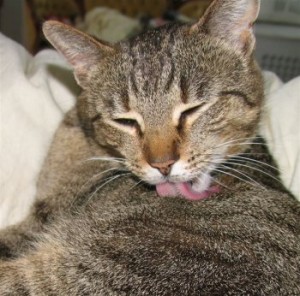Yes, You Can Talk to Your Pets
August 8, 2010 by LaBecs
Filed under Featured Articles
All animal lovers believe that their pets understand most of what they say to them, but it is a proven fact that both dogs and cats are capable of learning human language, not to the extent a child does, of course, but enough to be able to communicate. Your pets will never have the same extensive vocabulary as people, but they are capable of learning dozens if not hundreds of words. Yes, you can talk to pets.
Your pets love to interact with you, and talking to them often gives them the chance to be a part of your world and feel a lot closer to you.
Your pets crave the sound of your voice. They enjoy the attention you are giving them when you talk to them. The natural rhythm of conversation soothes them and pets detect the love and affection in your voice.
 People tend to change their tone and use very simple words when they speak to their pets, just like they do when they speak to children. However, there is no need to restrict your vocabulary since they are very good at understanding what you are saying. Obviously, they don’t understand the words immediately, they need a little coaching to be able to understand what you’re saying. They need to be taught a little.
People tend to change their tone and use very simple words when they speak to their pets, just like they do when they speak to children. However, there is no need to restrict your vocabulary since they are very good at understanding what you are saying. Obviously, they don’t understand the words immediately, they need a little coaching to be able to understand what you’re saying. They need to be taught a little.
At first, talk to them with simple and short words, but you don’t have to use only childish vocabulary. The more extensive vocabulary you use, the more words your pets will learn, and they will also learn to understand your voice inflections a lot better, so there’s no need to talk with an overly infantile voice as we tend to do…. you know: “Who’s momma’s baby? Who’s the baby?” Our tone of voice is important, however. If we use a high pitched, happy voice, it will get them excited. If we lower our pitch and speak calmly, we’ll be able to sooth them, if we use s stern and harsh tone, they will know they did something wrong. Keep in mind that even though pets are capable of understanding words and phrases, they can’t relate them to something that they can’t see. You can’t scold your cat for something he did 10 minutes ago, but he will understand if you scold him at the very moment he’s caught doing the bad deed.
One thing that’s important is that both dogs and cats need to hear the same words and phrases repeatedly to learn them. Just like when you say to your family “Dinner’s ready”, somehow they know what’s coming because they have experienced that whenever you say that phrase, food’s on the table. This means that in order for them to really understand the meaning of a word or phrase, it has to be followed by an action. If you tell your cat “come here”, he won’t know what you’re talking about unless you coach him to come to you in  some way. It’s very important that the first word you use when you talk to your pets is their name, that’s the way to get their attention, but once you get their attention, you need to follow up with some action so that they won’t start tuning out knowing that nothing happens when they turn to see you.
some way. It’s very important that the first word you use when you talk to your pets is their name, that’s the way to get their attention, but once you get their attention, you need to follow up with some action so that they won’t start tuning out knowing that nothing happens when they turn to see you.
You can also use hand signals and body language to communicate with your dog or cat. For instance, when you want him to stop, stand still and give them a palm-out signal. If you want them to come to you, bend down and pat your knees.
Another thing you can do to communicate is learn their language. With dogs it’s a little harder. If you try to bark or growl they’ll just look at you as if you’re crazy, dog language has a very distinctive accent, you might say. But your cats are a different story. If you approach a cat using cat language, look at her sideways and blink your eyes to give a peaceful greeting. If you want her to relax, purr, or if you want to scold her, hiss.
Whatever language you decide to use, whether it’s body language, hand signals, cat language dog language or human language, it’s important that you communicate with your pets. It will definitely deepen your bond and make your life together a lot more interesting.
How to Prevent Nasty Hairballs!
January 31, 2010 by LaBecs
Filed under How to Prevent Nasty Hairballs!
Watch any cat for a few minutes, and if he or she’s awake, you’ll see them grooming themselves with the help of their rough pink tongue. While this is a natural part of cat behavior, it is also the main cause of hairballs.
A hairball is just what it sounds like: a ball of hair. The technical term is trichobezoar. If you get hair in your mouth, you can just spit it out. But you cat can’t do that. Instead, she has to swallow the hair that comes off on her tongue during grooming. The bad news is hair can’t be digested.
Normally that’s not a problem either. The hair can still pass through the digestive tract and come out as part of the waste. However, sometimes the hair builds up in the stomach and can’t pass through the cat’s intestines. When that happens, the only way your cat can get rid of the nasty ball of hair is by throwing up!
Although seeing a cat vomit can be a disgusting and nauseating process to witness (the sounds alone make some pet owners gag), it’s better than the alternative. When your cat can’t throw up the hairball, they could end up with an obstruction that could be life-threatening and require surgery. Most feline owners would rather clean up a disgusting hairball then watch their beloved pets go under the knife.
But, thankfully, we have more options. We can actually prevent the formation of hairballs and reduce the risk of complications. Here are three tips that can help you help your cat.
Method #1: Reduce Excessive Hair
 When your cat is shedding a lot or needs a good brushing, he or she is more likely to develop hairballs that will need to be coughed up. You can help by spending time each day brushing your cat. Some cats love being brushed and will actually beg you to do it. Others aren’t crazy about being restrained and brushed so they are more resistant. But you can teach your cat to like getting groomed. Over time, even the most reluctant cat usually learns to love being brushed. Besides helping get rid of too much hair, regularly brushing reduces the amount of shedding your cat does (that’s good news for your furniture and clothes) and provides you with a great opportunity for bonding.
When your cat is shedding a lot or needs a good brushing, he or she is more likely to develop hairballs that will need to be coughed up. You can help by spending time each day brushing your cat. Some cats love being brushed and will actually beg you to do it. Others aren’t crazy about being restrained and brushed so they are more resistant. But you can teach your cat to like getting groomed. Over time, even the most reluctant cat usually learns to love being brushed. Besides helping get rid of too much hair, regularly brushing reduces the amount of shedding your cat does (that’s good news for your furniture and clothes) and provides you with a great opportunity for bonding.
Method #2: Give Special Treats as treatment
If you look at the treat section of your pet store, you’ll probably find some specially formulated treats designed to help break down hairballs in your cat’s stomach. Most of these treats come in delicious flavors – at least as far as your cat is concerned – so they eat them well. This might be a good idea if you notice your cat coughing up a lot of hairballs, or even just coughing without throwing anything up.
Method #3: Pass the Hairball
Sometimes a stubborn hairball can use a little help. Most pet stores also carry petroleum-based products that can be used to lubricate the cat’s hairball and intestines to make its passage easier. These products are 100% safe and come in cat-friendly flavors. Sometimes they can be added to the cat’s food.
A combination of all these methods can help control your cat’s hairball problem and can prevent life-threatening complications. And for you, the advantage is that you’ll spend more time grooming your cat, and less time cleaning up.
The Differences Between Cats and Dogs
August 10, 2009 by LaBecs
Filed under Differences Between Cats and Dogs
We could spend years debating why are cats and dogs different? But, the answer is easy… they are different species. While it can take weeks to train a cat to “come” or “sit”, dogs can learn this behavior in just about five minutes. On the other hand, cats learn to use a litter box with almost no training, but it can take tons of persistence to do the same with a small dog. It’s obvious that what’s important for dogs is not important for cats and vice versa. 
The main difference is this: dogs are pack animals; cats tend to be more independent, though not solitary animals as some perceive them.
Dogs are social creatures and are happy and content in a group situation.
If an owner provides proper leadership, he or she becomes the pack leader and the dogs will view them with respect. However, if they are treated badly, they will still remain in the pack because they are attached to their people.
Cats form groups, but there is not a structure of leadership. They are very territorial but they will share their territory, as long as their needs are met and they’re not treated badly.
Dogs normally attach to its group, and not their surroundings. You can take your dog to work with you or move to another house, and the dog will be happy as long as he’s with you. Although cats also get attached
to people, if you take your cat away from its regular surroundings, he or she will develop fear and anxiety.
Dogs learn everything from observing other pack members. They learn by interacting with their owners.
When the leader uses rewards to get behaviors that will ‘group the pack’, such as “come” or “sit”, dogs respond promptly. It’s embedded in their DNA. Dogs can be trained because they desire to please their owners.
Cats…. well, it’s not the same with them.
Dogs also learn what not to do when another member of the pack growls or snips at them. The dog will avoid repeating the situation, especially to please a high ranking member of the pack. That negative reinforcement works with dogs, but a cat, will avoid the source of the punishment, clearly, their owner, so punishment will not work on a cat.
 Picture a hunting situation in the wild with a cat: she goes out hunting alone, stalks her pray, and in case of danger, she can jump and climb to get away. Now picture a dog in the same situation. He follows his pray through scent, but he’s not very stealthy. If confronted, he will have to fight. Dogs use fighting to defend themselves; cats are agile enough to escape. The concept of ‘flight or fight’ is very important for dogs. That’s why hunting in a pack is what’s effective for them.
Picture a hunting situation in the wild with a cat: she goes out hunting alone, stalks her pray, and in case of danger, she can jump and climb to get away. Now picture a dog in the same situation. He follows his pray through scent, but he’s not very stealthy. If confronted, he will have to fight. Dogs use fighting to defend themselves; cats are agile enough to escape. The concept of ‘flight or fight’ is very important for dogs. That’s why hunting in a pack is what’s effective for them.
What does all this mean?
The difference between cats and dogs can be summarized beautifully with this statement: “My dog looks at all the things I provide for her and says ‘You must be God.’ My cat looks at all the things I provide for him and says ‘I must be God’”.
Excessive Grooming in Cats
June 6, 2009 by LaBecs
Filed under Excessive Grooming in Cats
In many cases, our pets develop issues that need special attention and there may be signs of potential problems. One of these issues is apparent when you observe excessive grooming in cats.

Beluga
Cats must groom themselves. It’s a natural part of their behavior. However, under some conditions, cats can groom themselves excessively. While you may not think this is a serious issue, it can be. If you notice excessive grooming in your cat, pay attention. They will vomit hairballs more often. In any case, try not to let it go on too long. The cat can end up with bald or red spots in certain areas of her skin, or an open sore.
Excessive grooming in cats can be linked to a lack of attention, boredom, insufficient grooming by the owner, and even separation anxiety. Many of us have a misconception that cats don’t need attention because they are aloof, independent, and free-spirited. That’s not the case. They may not be as needy as dogs but that doesn’t mean they don’t need attention and affection regularly.
If you notice your cat grooming too much, try distracting him or her, play a little bit. If the behavior then stops, you can attribute it to boredom and then you might help by providing more distractions. However, if the cat goes back to grooming right away take him or her to the vet as soon as possible. The vet can rule out parasites or a fungal infection. Your cat may be having an allergic reaction or could be suffering from an autoimmune problem. He or she can help treat the medical problems and can also assist you in stopping the behavior to prevent future medical issues. The vet might prescribe antihistamines, herbal calming remedies, and antianxiety medications that can help break the cycle and calm your cat.
While knowing what caused the behavior is not always necessary for effective treatment, it may help you to understand what brought about your cat’s obsession with excessive grooming. Changes in the environment and the resulting stress can sometimes be a cause. For example, if you have just added a new member to the family – feline, canine, or even human.
You won’t be able to tell from the behavior itself whether the cause is psychological or physical, but excessive grooming should definitely be discussed with your vet, especially if it accompanies other changes in your cat’s behavior, such as reduced energy levels.
The bottom line is that you should talk to your vet if your cat’s behavior disturbs you in anyway. Observe your cat and groom him or her yourself regularly. Being aware of any changes in your cats behavior can avoid difficult medical problems down the line.
Good Reasons to Keep Your Cat Indoors
May 29, 2009 by LaBecs
Filed under Good Reasons to Keep Your Cat Indoors
For many cat owners, the choice of whether to keep their cat indoors or to let it roam free at least part of the time is difficult. Some cat lovers believe keeping your cat cooped up indoors all of the time amounts to cruelty. Other cat lovers argue that the dangers of allowing domesticated cats to run in the streets far outweighs any potential benefits for the cat. From the title of this piece, you can probably guess which side of the issue I’m going to side with. But I think it’s important for people to realize how dangerous things can be for cats on the streets.
The Disease Factor
Cats that spend even part of the time outside are at a significantly higher risk of catching one of the common feline diseases than those who live indoors. And don’t assume your cat is not at risk because he or she has been vaccinated. According to the Community Animal Welfare Society, most vaccines only provide up to 85% protection against these diseases so your cat is still a risk of becoming gravely ill.
Feline Leukemia is one of the most common diseases in cats and is transmitted through cat saliva, which means a stray cat that licks your roaming pet or a water source used by multiple cats can be a source of the disease. A second serious disease is Feline Immunodeficiency Virus (FIV). This disease is transmitted through cat blood so if your pet becomes involved in a fight with another cat while roaming outdoors he could contract the disease. Unfortunately, FIV is fatal and no cure is available at this time.
The Human Element
While cats do run a serious risk of catching disease from other felines outdoors, that’s not the only risk they face. Not everyone in your community is going to appreciate the activity of these free-roaming cats. A neighbor fed up with the cat’s visits to their yard, might deliberately leave out poisoned cat food or other dangerous things for cats. In other cases, toxic chemicals, such as those in antifreeze, are located in places where cats like to end up and can result in their death.
Humans can also be cruel. Around Halloween every year, hundreds of black cats are killed around the country in pranks. Cats that roam the streets are a very likely target for this type of behavior, especially since most owners let them out for the night when pranksters are most often on the prowl. They can also be caught and sold to research facilities, or taken to a shelter, where they will be euthanized in as little as 2 days if you don’t know he is lost.
Other Risks
Besides disease and human cruelty, roaming cats have other reasons to be afraid. They are an easy victim for dogs and other predators, and traffic. Who knows how many pets can be found flattened on the pavement every night. Cats can also be killed by cars in other ways since they like to sleep under them.

Build a Nice Outside Area
Cats that run in the neighborhood are also much more likely to contribute to the out-of-control cat population. Unless you have spayed or neutered your free roaming feline, you are undoubtedly adding to the problem. Too many cats are already euthanized daily because they do not have a proper home.
In some cases, very cruel owners will have their cats de-clawed but still allow them to roam the streets at night. This leaves the cat defenseless in the face of an attack. Not only can the cat not fight back against predators or other cats, but he or she cannot even scale a tree or a fence for protection from the attackers or from other threats.
The bottom line is that letting your cat outside provides no real benefits – only very real risks – to your cat’s health and safety. Don’t do it.
If you feel your cat is missing out, provide him with a good cat condo, if you lack the space you can always buy cheap Ikea shelves, glue on pieces of carpet that you can get as scrap at carpet places, and put them on the wall so your cat can climb up on the wall. They even look cool!
Give him or her a nice window seat to look out.
Teach them to walk on a leash. Yes they can be trained. They will initially feel confined by the harness, and their first attempts at walking on a leash might look uncomfortable and a waste of time, but with love and patience on your part, most cats will enjoy leash walking.
Build them an outdoor condo where they can come out and enjoy the sunshine if you have the space. You don’t have to spend a fortune.
Get them a mesh front carrier. Most are for dogs, but they can be used for cats as well. You can take them with you and go for walks, or get them a kitty stroller. You can get them at good prices online.
The point is, you can keep them safe and satisfied, and exercised, and they will never miss the great outdoors.
Mistakes New Cat Owners Shouldn’t Make
March 13, 2009 by LaBecs
Filed under Mistakes New Cat Owners Shouldn't Make
Getting a cat is a big step and there are some mistakes one should avoid. Cats have a reputation for taking care of themselves, but that doesn’t mean they don’t need any care. Before deciding to adopt that beautiful kitten, take the time to do some homework, thus avoiding these common mistakes made by new cat owners. That way you will have a happier and healthier cat and a long-term companionship with another living being, the like of which you never dreamed.
Adopting in a Rush
If you feel the impulse to buy a new shirt, or a new pair of shoes, you can always return it if it doesn’t fit right or if it’s the wrong color. But adopting a living creature like a cat or kitten, that will become a family member, is a different matter.
Adopting a new cat should be for keeps, so consider carefully before you make that decision.
You need to know that it’s going to cost money to support it. You have to get toys, food, litter boxes, veterinary visits, etc. You owe it to your new cat to take care of his basic needs, as well as being prepared for emergencies.
Not Spay or Neuter a New Cat
People who failed to spay or neuter their cats always complain of male cats spraying every available surface of the house or escaping outdoors to fight other male cats; female cats who keep the whole family awake with their loud yowling during estrus; and worse yet, “surprise” litters of unwanted kittens. Society faces an overwhelming cat population problem and that is reason enough to spay and neuter. Spaying or neutering your cat will also have many health advantages, so you have no reason not to do it.
Not Giving Needed Veterinary Treatment
Cats may quickly recover from minor illnesses, but they can also die if an emergency isn’t recognized. Cats need vaccinations, annual examinations, and they definitely need and deserve immediate veterinary care when they become sick or injured.
First Thing to do is choosing a good veterinarian.
Wrong Cat Food Choices

Anastasia
You might save some money by buying cheap cat food, but then you’ll have to spend much more on veterinary care. Cats are carnivores and need a good source of meat protein. They do not need large amounts of grain fillers, especially corn, which is a cheap source of protein used by many cat food manufacturers. Learn how to choose cat food and select the best brands you can afford. Your cat might eat less of the high quality food because they don’t have to gorge to get the nutrients they need.
Declawing Without All the Facts
Many innocent new cat owners have been convinced to declaw when a veterinarian asks: “Do you want your kitten declawed when we spay her?” Some veterinarians consider declawing a “routine” surgery, but cat advocates consider it cruel, inhumane, and unnecessary in almost every case and I totally agree. Learn the facts so that you can make an informed decision.
Allowing a Cat to Roam Free Outdoors
Many people believe cats are happier being free, breathing fresh air, and basking in the sunshine of an outdoor life, while many others can assure you that cats can be very happy and healthy living totally indoors. The outdoors offers dangers not found inside and that cannot be denied. Fortunately, there are many compromises that will give you and your cat the best of both worlds, while keeping him or her safe and happy.
Poor Litter Box Maintenance
Cats will always use their litter box, as long as it’s kept very clean, and the litter is not scented or unpleasant to the cats’ feet. Carefully maintaining your cat’s litter box will almost always guarantee you that you will not be faced with litter box avoidance problems.
However, if your cat suddenly starts urinating outside the box despite your careful maintenance, you should immediately have it checked for a urinary tract problem with your veterinarian.
A Cat is Not Property
When you join the ranks of cat lovers, you’ll find that we refer to our cats as family members, rather than “pets.” While cats may legally be considered “property” in some jurisdictions, the term ends there. If you haven’t figured out the distinction by now, your new cat will let you know in no uncertain terms. In fact, many cat lovers describe themselves as being owned by their cats!
Ignoring them
We always hear that cats are independent and should just be left alone. You will soon find out that they are very loving creatures that long for their human’s company. They will follow you around like a puppy, and will want to play with you. Play with them to keep them sharp and interested. The more toys they have the better, and you don’t have to spend a fortune. You’ll find how to make cheap toys in later articles.
Not Allowing a Cat to Be a Cat
Cats’ unique ways make them the endearing creatures they are. Some of their traits, however, may cause frustration because we don’t understand their needs. Cats instinctively seek out high places and sharpen their claws because they are cats, not because they are stubborn and disobedient. Our job is to accommodate those needs in acceptable ways.
Forcing your Love on them
They are sooo cute!!!! You just want to eat them up, hug them and squeeze them. But this is the fastest way to annoy them and make it harder to bond with them in the long run. Although many cats are all for it, many others are not quite as eager to be hugged. Take your cues from them, they will let you know what they like, never doubt that.
Ten Facts About Cats
May 15, 2011 by LaBecs
Filed under Top Ten Facts About Cats
You think you know everything about your cat? There are some fun and interesting facts that you don’t need to know, but, you can use them to impress your friends one day.
 1.- A cat can travel at a top speed of approximately 31 mph over a short distance.
1.- A cat can travel at a top speed of approximately 31 mph over a short distance.
2.- A cat’s hearing is better than a dog’s.
3.- A cat can hear high frequency sounds up to two octaves higher than a human.
4.- A cat can jump up to five times its own height in a single bound.
5.- Cats can make over 100 vocal sounds while dogs can only make 10.
 6.- When cats are happy they squeeze their eyes shut.
6.- When cats are happy they squeeze their eyes shut.
7.- Cat’s noses are like fingerprints: every nose pad is different.
8.- A group of cats is called a clowder.
9.- A female cat is called a queen or a molly.
10.- Cats sleep between 16 and 18 hours a day.


